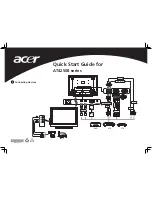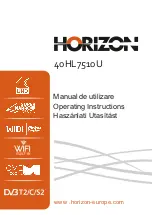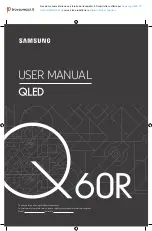
Circuit Descriptions, List of Abbreviations, and IC Data Sheets
9.
5V2 Stabilization and Feedback
The Standby Power Supply always oscillates at maximum
power. The only limiting factor is the maximum primary current,
which has been preset with R3108//3118.
R3113, zener diode D6122, R3124, and R3114 determine
U
OUT
. If the voltage across R3114 exceeds the threshold
voltage of the diode of the optocoupler 7104 (
±
1 V) or, in other
words, UOUT exceeds 5.2 V, the transistor of the optocoupler
will conduct.
Transistor TS7100 is now driven, and a negative voltage will be
transposed to the emitter of TS7101. When TS7101 conducts,
the gate of the FET is at earth potential, forcing the oscillator to
stop. Due to the load, the secondary voltage U
OUT
will
decrease. At a certain voltage, optocoupler TS7104 will block
and the oscillator will start again.
Since there are no capacitors, and there is a high amplification
factor in the feedback circuit, the feedback is ultra-fast. This is
why the ripple on U
OUT
is minimal. The negative supply voltage
(-20 V) used in the feedback circuit originates from the co-
coupling coil, and is rectified through D6103.
Stabilization is not effected through duty-cycle control, but
through the burst-mode of TS7100.
Burst-mode is load dependent. If the power supply is less
loaded, the secondary voltage will have the tendency to
increase more rapidly. If the load on the power supply
increases, then the oscillator stops less often, right up to the
moment that the oscillator is operating continuously: maximum
load. If the power supply is now loaded even more, the output
voltage will decay. The maximum primary current set by
R3108//3118 determines the maximum load.
8V6 Stabilization and Feedback
In general, with a flyback supply with multiple outputs, as used
in the former chassis, one of the output voltages is controlled
via the primary feedback loop. The additional secondary output
voltages are determined via the turn-ratio of the transformer.
It is often seen that a linear voltage regulator is used for post
regulation of the non-primary regulated secondary voltages.
The disadvantage of this approach is the power loss in the
linear voltage regulator.
For this chassis, a power economic solution is achieved, by
implementing a kind of secondary down-converter. The
advantage, compared to a conventional down-converter, is that
no extra coil is required. It is using the inductance of the main
transformer. This way one large current coil, a power diode,
and one elcap are saved.
Figure 9-5 Circuit principle
A basic flyback converter is used, with a MOSFET Q1,
transformer L1, and a primary feedback circuit. The output of
the primary controlled voltage is U1.
The additional secondary controlled supply consists of D2 and
Q2, with output voltage U2.
The main flyback supply is working independently, where the
duty cycle is controlled via the primary feedback, and the
MOSFET Q1 is switching at a certain frequency. MOSFET Q2
is also switching at the same frequency, as it is synchronized
with Q1.
Figure 9-6 Timing diagram
•
Time interval t0-t1:
The primary MOSFET Q1 is switched
'on,' both diodes D1 and D2 are blocked.
•
Time interval t1-t2:
MOSFET Q1 is switched 'off' and Q2
is switched 'on.' During this period, the energy is
transferred to output U2 of the supply. Diode D1 is blocked,
because U3 is lower than U1.
•
Time t2:
Q2 is switched 'off.'
•
Time interval t2-t3:
During this period, the rest of the
energy will be transferred to output U1.
The two controllers, the primary feedback for U1, and the
secondary feedback for U2, all work independently.
The secondary voltage U2 is controlled by the 'on' time of Q2.
As soon as the load on U2 increases, the 'on' time of Q2 (the
period t1-t2) is automatically increased by the secondary
feedback. More energy will be taken by the output U2, and less
energy will be transferred to U1. Voltage U1 will drop
automatically. The primary feedback loop will change the
primary drive to enlarge the total amount of energy to be
transferred, from the primary side, and U1 will rise again.
Protection
If the optocoupler fails, the secondary voltage will increase.
This would have disastrous consequences since many ICs (for
example, Painter, Flash-RAM and DRAM) are fed with this 5.2
V. In other words, very expensive repairs would be required.
We already know that the negative supply is directly dependent
upon the secondary 5.2 V, because of which the negative
supply will increase proportionally as the secondary voltage
increases.
If the negative supply, in the mean time, reaches -25 V, D6106
will start to zener and TS7101 will start conducting. D6106 will
take over the stabilization task of the optocoupler, however,
with a considerable spread: from -20 to -25 V is a 25 %
increase, thus UOUT will increase from 5.2 V to a maximum of
6.5 V.
Tuner Supply
The Standby supply produces the +33V (V
TUN
) voltage for the
tuner. The +33V is the tuning voltage for the Tuner. The +5VT
CL 26432041_080.eps
170402
C1
Q1
FEEDBACK
7103/04
C4
U2
(+8V6)
MOSFET
DRIVER
D
G
S
C2
Q2
D
G
S
C6
D1
D2
I2
I1
L1
U1
I3
C5
7133
R5
C7
C8
R1
R7
R6
R8
R9
R4
R3
FEEDBACK
DRIVER
U3
(+5V)
FEEDBACK
315V
+
+
+
-
-
-
CL 26432041_079.eps
170402
t0
Vg-Q1
Vg-Q2
V-D1
V-D2
I1
I2
I3
t1 t2
t3
Содержание EM1.1A
Страница 35: ...Circuit Diagrams and PWB Layouts 35 EM1 1A AA 7 Layout LSP Top Side ...
Страница 37: ...Circuit Diagrams and PWB Layouts 37 EM1 1A AA 7 Layout LSP Overview Bottom Side ...
Страница 38: ...38 EM1 1A AA 7 Circuit Diagrams and PWB Layouts Layout LSP Part 1 Bottom Side ...
Страница 39: ...Circuit Diagrams and PWB Layouts 39 EM1 1A AA 7 Layout LSP Part 2 Bottom Side ...
Страница 40: ...40 EM1 1A AA 7 Circuit Diagrams and PWB Layouts Layout LSP Part 3 Bottom Side ...
Страница 41: ...Circuit Diagrams and PWB Layouts 41 EM1 1A AA 7 Layout LSP Part 4 Bottom Side ...
Страница 65: ...Circuit Diagrams and PWB Layouts 65 EM1 1A AA 7 Layout SSB Part 1 LOT Side CL 36532061_21a eps 270803 Part 1 ...
Страница 66: ...66 EM1 1A AA 7 Circuit Diagrams and PWB Layouts Layout SSB Part 2 LOT Side CL 36532061_21b eps 270803 Part 2 ...
Страница 67: ...Circuit Diagrams and PWB Layouts 67 EM1 1A AA 7 Layout SSB Part 3 LOT Side CL 36532061_21c eps 270803 Part 3 ...
Страница 68: ...68 EM1 1A AA 7 Circuit Diagrams and PWB Layouts Layout SSB Part 4 LOT Side CL 36532061_21d eps 270803 Part 4 ...
Страница 70: ...70 EM1 1A AA 7 Circuit Diagrams and PWB Layouts Layout SSB Part 1 LOT Side CL 36532061_22a eps 290803 Part 1 ...
Страница 71: ...Circuit Diagrams and PWB Layouts 71 EM1 1A AA 7 Layout SSB Part 2 LOT Side CL 36532061_22b eps 290803 Part 2 ...
Страница 72: ...72 EM1 1A AA 7 Circuit Diagrams and PWB Layouts Layout SSB Part 3 LOT Side CL 36532061_22c eps 290803 Part 3 ...
Страница 73: ...Circuit Diagrams and PWB Layouts 73 EM1 1A AA 7 Layout SSB Part 4 LOT Side CL 36532061_22d eps 290803 Part 4 ...
Страница 116: ...116 EM1 1A AA 7 Circuit Diagrams and PWB Layouts Personal Notes E_06532_013 eps 131004 ...
















































